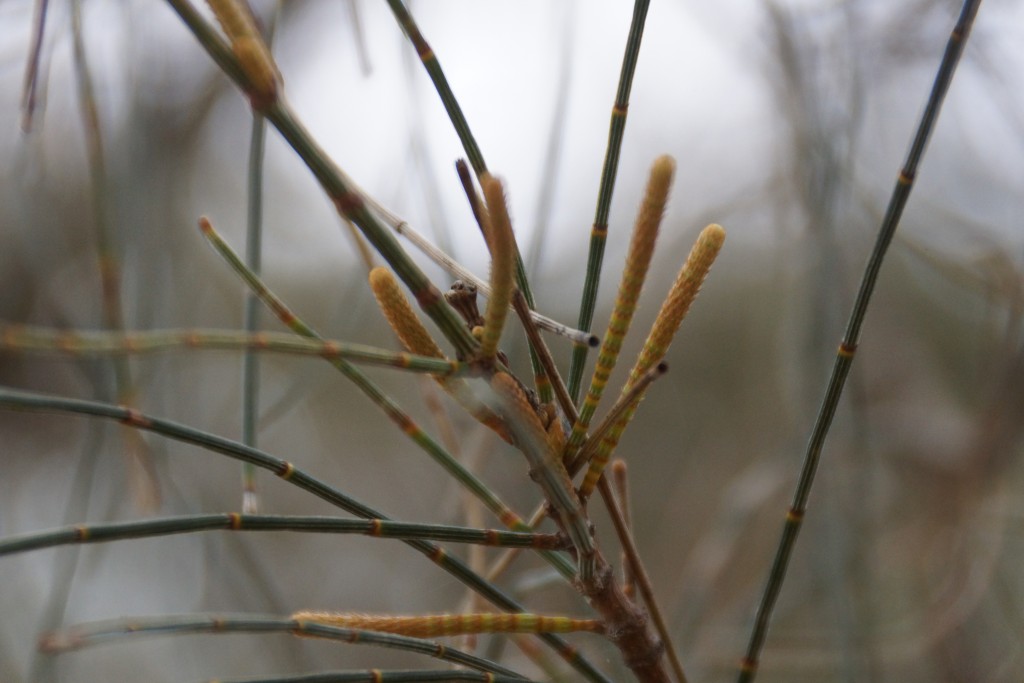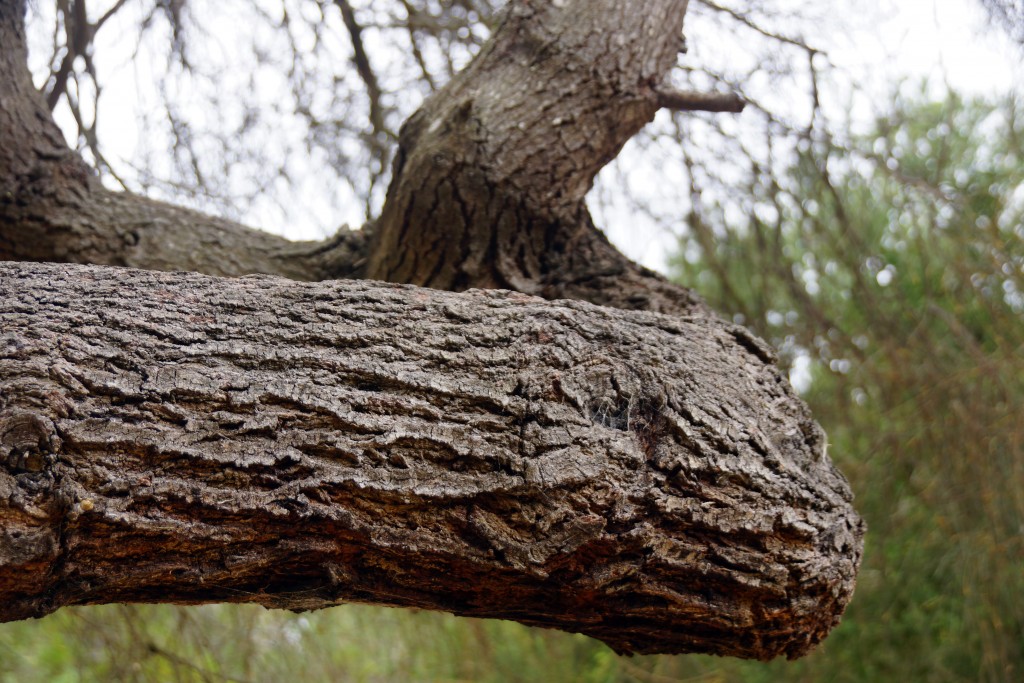 The Drooping She-Oak (Allocasuarina verticillata) is uniquely indigenous to Australia. Often mistaken for as a pine tree due to its needle like foliage, drooping habit, cones, and mystical whistling sound as the wind blows – it is actually a highly adapted miracle plant, that has evolved to survive the most hostile of environments – including infertile soils, drought, frost, salt, . . .
The Drooping She-Oak (Allocasuarina verticillata) is uniquely indigenous to Australia. Often mistaken for as a pine tree due to its needle like foliage, drooping habit, cones, and mystical whistling sound as the wind blows – it is actually a highly adapted miracle plant, that has evolved to survive the most hostile of environments – including infertile soils, drought, frost, salt, . . .
Often found in soils devoid of nutrient, the She-Oak is able to take nitrogen from the air and deposit it into the soil via the nitrogen-fixing, soil borne bacteria, ‘Frankia’. Interestingly, much of the new nitrogen entering soils comes from this genus of bacteria, that tends to live in root nodules on ‘actinorhizal plants’. Frankia sp. is a filamentous bacteria that cleverly converts atmospheric Nitrogen gas into Ammonia thereby ‘fixing’ and supplying most, if not all, of the host plants’ nitrogen needs. Consequently, ‘actinorhizal plants’ colonise and often thrive in soils that are low in combined nitrogen.
 She-Oak roots have also developed a symbiotic relationship with the subterranean Mycorrhiza Fungi, which similarly enables them to fix their own nitrogen, as well as provide nutrients. In the right conditions, this fungi produces fruiting bodies, known as truffles, which bandicoots, potoroos, bettongs search for, as they love this nutritious treat. The relationship between the trees, roots, bacteria, fungus, soils, and animals ensures this special relationship is maintained, i.e. the animals dig the soils, spreading and aerating as they search for the buried truffles. The truffles are eaten and pass through the gut of the animal, which pre-treats the spores ready for germination. The spores are dispersed via the animals droppings and so, the cycle continues . . .
She-Oak roots have also developed a symbiotic relationship with the subterranean Mycorrhiza Fungi, which similarly enables them to fix their own nitrogen, as well as provide nutrients. In the right conditions, this fungi produces fruiting bodies, known as truffles, which bandicoots, potoroos, bettongs search for, as they love this nutritious treat. The relationship between the trees, roots, bacteria, fungus, soils, and animals ensures this special relationship is maintained, i.e. the animals dig the soils, spreading and aerating as they search for the buried truffles. The truffles are eaten and pass through the gut of the animal, which pre-treats the spores ready for germination. The spores are dispersed via the animals droppings and so, the cycle continues . . .
Coupled with the intimate relationship with the fungi and bacteria, is the cleverly adapted foliage. She-Oak foliage which resembles the needles of a pine tree, are actually very finely ridged tiny branches or ‘branchlets’. Microscopic examination reveals tiny scales, which are in fact the true ‘leaves’ of the She-Oak. Pores found within the epidermis of leaves, stems, and other organs (stomates) are used to control gas exchange, and are essential for a plant’s survival. These are normally located on the surface of the leaves, however, in She-Oaks, they are found on the inside furrows of the scales of the branchlets – resulting in minimal water loss by the plant.
 Traversing through any cluster of She-Oaks, one will notice a delightful blanket of needles carpeting the ground beneath. This is another water saving feature of the plant. As the tiny branchlets fall, they form a thick blanket of rich mulch which not only minimises evaporation, it also suppresses weeds and helps stabilise the soil from erosion.
Traversing through any cluster of She-Oaks, one will notice a delightful blanket of needles carpeting the ground beneath. This is another water saving feature of the plant. As the tiny branchlets fall, they form a thick blanket of rich mulch which not only minimises evaporation, it also suppresses weeds and helps stabilise the soil from erosion.
As much as small native animals of a She-Oak woodland enjoy the truffles, the tree also provides food and shelter for many native birds. For example, the majestic Black Cockatoo loves the seeds within the cone. To access this yummy treat, they hold the cone with their feet, shred it with their powerful beaks, and remove the seeds from the cone with their tongues. Finches and many of the parrot family enjoy the seeds of the She-Oak – whilst Willie Wagtails, Pee Wees and Butcher Birds forage for the many insects that inhabit the numerous branchlets – as well as build their nests within the crown of the tree.
Description
 The Drooping She-Oak (Allocasuarina verticillata) is a medium-sized; multi-branched, bushy tree with a rounded head extending some 3-5 m in diameter – the tree grows between 5-10 m tall. It was the drooping nature of the branchlets, and the oak like nature of the wood, that gave rise to the common name ‘Drooping She-Oak’.
The Drooping She-Oak (Allocasuarina verticillata) is a medium-sized; multi-branched, bushy tree with a rounded head extending some 3-5 m in diameter – the tree grows between 5-10 m tall. It was the drooping nature of the branchlets, and the oak like nature of the wood, that gave rise to the common name ‘Drooping She-Oak’.
The word ‘Casuarina’ is derived from the Latin word ‘Cassowary’, presumably adapted due to the fine, textured evergreen foliage of the She-Oak, that resembles the plumage of a Cassowary. Interestingly, in 1982 many of Victoria’s Casuarinas were controversially transferred to a new genus named ‘Allocasuarina’ – Allo being Greek for ‘other’.
‘Verticillata’ – is Latin for ‘arranged in whorls’ i.e. circles of three or more leaves, flowers, organs that surround the same part or joint of a stem. The number of leaves in the whorls are important factor in identifying She-Oaks.
The bark of the Drooping She-Oak is tough, dark and corrugated – ideally designed to protect against abrasive, sand-laden, coastal winds . . . The rough bark tends extends up the trunk and then becomes significantly smoother on the branches.
Propagation
 She-Oaks are dioecious – meaning they are either a male or a female. Male trees produce tan-coloured strings of ‘beads’ which hang down from the ends of the branches, whereas the female flowers are more like small orange-red rounded tufts – generally situated along the branches, which hang well out – presumably to catch the wind-borne pollen grains emitted from a nearby male.
She-Oaks are dioecious – meaning they are either a male or a female. Male trees produce tan-coloured strings of ‘beads’ which hang down from the ends of the branches, whereas the female flowers are more like small orange-red rounded tufts – generally situated along the branches, which hang well out – presumably to catch the wind-borne pollen grains emitted from a nearby male.
The resultant woody, barrel-shaped, seed-bearing cones develop from a small, shiny, copper colour – to a mature, dull, spikey, dusty brown – each holding some 100+ small, black seeds, which are encased within the sharp spikey ‘valves’. These valves open with heat or old age. She-Oaks must be at least 7 years old to produce numerous seed-bearing cones. Facinatingly, the seeds can stay within the cones for up to ten years !!!
Fire is also an integral part of the She-Oak’s propagation and survival . . .
 Depending on the intensity and frequency of fires, the result can vary from prolific regeneration to total desertion.
Depending on the intensity and frequency of fires, the result can vary from prolific regeneration to total desertion.
Cooler Fires
Young trees are killed but will re-sprout – Older trees are unaffected but do not release seed
Medium Fires
Young trees are killed and do NOT re-sprout – The canopies of older trees are affected and some seed is released
Hot Fires
Both Young and Old trees are devastated – seeds are released from the cones. The seeds remain viable for up to 3 months and will often prolifically regenerate on the sterile, nutrient rich bed of ash created by a hot fire. Mindful of the fact that She-Oaks do not produce many cones until they are some 7 years of age – should another hot fire occur within 7 years of the previous one, the She-Oak will not survive . . .
European Uses
The She-Oak’s primary historical use was as firewood. Being a dense wood, it burns very hot, resulting in a pure white ash.
The ash was once used as a sheet whitener, prior to commercial whiteners; and for soap making. Soap was made simply by boiling the ash, being the alkali component, in fresh water – which was then mixed with liquefied fat; a scent added – and lastly, cooled.
The beautifully grained, and very strong timber was used to make everything from shingles, wagon bearings, bullock yokes, axe and tool handles – to the more delicate, high value, intricate items made from turned wood, delicate inlays, crafted boxes, high quality furniture, to name a few . . .
Today, the She-Oak is a proven and valuable wind break, a wonderful shade tree, and is now often used to vegetate the harshest of environments. Apiaries are also recognising the value of these trees for honey, as the honey bees are greatly attracted to their pollen.
Indigenous Uses
The Aborigines also had many uses for the valuable She-Oak, over and above the shade and shelter properties of the tree, some which were:
The tough wood qualities of the She-Oak was perfect with which to make spears and boomerangs.
The inner bark and sapwood shavings were soaked in water and the liquid gargled for toothaches.
Young cones were chewed to alleviate thirst whilst traversing long, hot, dry landscapes.
She-Oak logs were placed into creeks which would attract tasty, wood-eating grubs. The grubs were collected and eaten either raw or cooked.
Seeds were roasted and eaten.
Sap secreted by the tree was collected, chewed or melted with warm water to form a jelly prior to eating . . .
